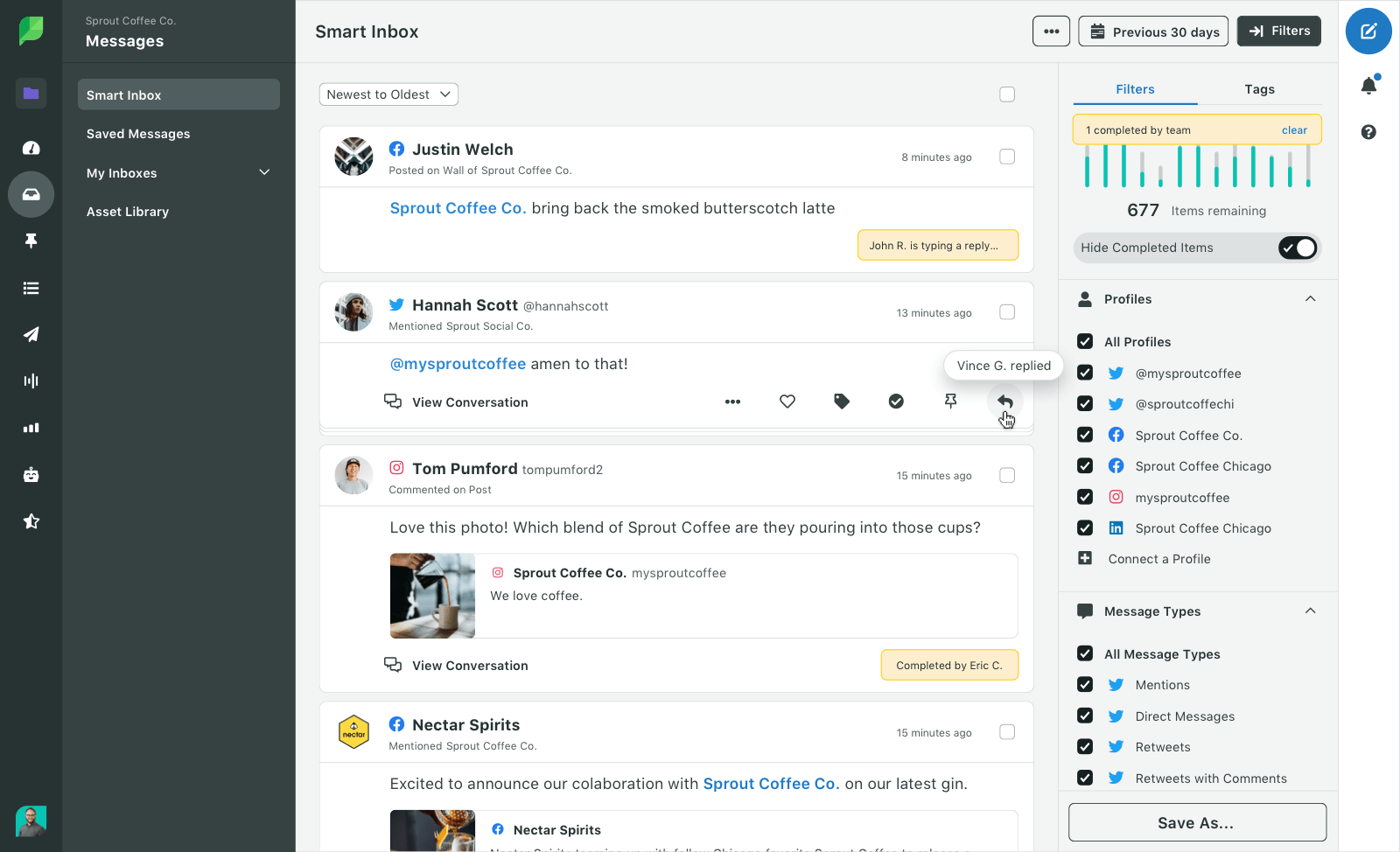How to create a social media crisis communication plan

Table of Contents
The reality is all businesses need a social media crisis communication plan.
Because social media meltdowns, pile-ons and controversies aren’t just reserved for the biggest companies anymore.
Recent engagement statistics highlight just how quickly social media moves for modern companies. When you’re always dealing with a flood of @mentions, messages and updates, it’s clear how mistakes can get made and spiral out of control.
The COVID-19 pandemic showed us a crisis can unfold whether we’re prepared or not. In March 2020, only 23% of US organizations had a dedicated crisis response team in place—despite 95% of global business leaders anticipating a crisis.
It’s essential to create a plan for when (not if) the unexpected happens on social media because your community expects to hear from you. And navigating a crisis well helps your business recover faster.
This guide breaks down how marketing and communications teams can handle a social media crisis and tips to prevent problems in the future.
What constitutes a social media “crisis?”
Fair question.
In short, a social media crisis represents any social media activity that potentially hurts your brand’s reputation or ability to do business.
Bear in mind that a “crisis” is much more than just a single negative comment or customer complaint. Indicators of a crisis could be anything from a flurry of negative comments to an outright boycott of your products.
Also, note that not all crises are totally within your control as a marketer. They can happen no matter how careful your brand is with its messaging.
How so? Let’s look at some social media crisis examples below.
Insensitive or out-of-touch comments
Perhaps the most common–and preventable–type of crisis comes from saying something offensive or insensitive.
We see such snafus often from celebrities and influencers. Chalk it up to a lack of self-awareness or not having a second opinion to say “Hey, maybe you shouldn’t post this.”
Consider the recent backlash from actress AnnaLynne McCord’s insensitive poem on Twitter regarding the crisis in Ukraine. The video has more than 38.1 million views so far.
Commenting on an international crisis with a poem was both out-of-touch and privileged, to say the least. McCord has since doubled-down on her perspective, despite negative feedback and press.
Errors in judgment aren’t just restricted to celebrities. For example, Amazon Prime had to delete an insensitive tweet joking about finding “apocalypse buddies” the day of the Ukrainian invasion. Responses online were swift and unforgiving.
A quippy Tweet about the apocalypse may not be offensive on its own. However, the timing of the Tweet was definitely in poor taste. After quickly deleting the post and pausing content for the rest of the day, they Retweeted a message regarding their support for Ukraine from Amazon News a few days later.
Product fails and customer criticism
Social media and community managers serve as the sort of mouthpiece for their respective brands online.
And if a product you’re putting out doesn’t deliver or results in bad press, you’re going to be taking the brunt of the criticism.
Take haircare company Olaplex. A number of beauty influencers took to social media to speak out against their products after previously promoting them to followers and fans.
The controversy began when it was revealed that the European Union (EU) determined an ingredient in one of Olaplex’s formulas was linked to infertility. Consumers took to social media to share their concerns and their plans to boycott the brand.
This controversy highlights how quickly a social media crisis can unfold.
Olaplex promptly addressed the allegations against their products and worked to stop the spread of misinformation. They shared published findings from third-party academic sources and communicated transparently with their community.
Although it’s too soon to know the full impact of this crisis, it seems that Olaplex will be able to move forward with limited damage to their reputation.
Employee errors and bad behavior
Sometimes all it takes is one employee’s misconduct to start a crisis.
Take the recent leaked email thread from an Applebee’s executive making the rounds on social media. In the email, he celebrates high gas prices as a means to stop paying workers better wages.
The repercussions were immediate. The brand’s culture was understandably dragged on social media. The crisis escalated as press coverage exploded and many employees quit the franchise.
Backlash gone viral
As noted earlier, sometimes a crisis occurs due to something beyond a social manager or marketing department’s control. It can instead stem from larger cultural issues within an organization.
Last year luxury retailer Coach came under fire for destroying their surplus purses and shoes, despite making sustainability claims on their website. A TikTok went viral depicting “purse-slashed” leftover merchandise found in the trash.
The company later confirmed this practice had taken place, but shared their plans to update their policies following the scandal.
Site outages and broken links
Although there’s a gray area on what kind of outages constitute a “crisis,” they can definitely become bigger problems if you aren’t paying attention.
Let’s say you’re in the midst of a product launch and your site goes down. Or maybe you’re promoting an irresistible offer to your customers and your links are broken.
If so, an explosion of @mentions and complaints could very well come your way.
The good news is that these sorts of crises are the easiest, granted you’re equipped to respond and fix the issue in a timely manner that satisfies customers’ needs.
Real-world crises, global events and tragedies
If we’ve learned anything the past few years, it’s that brands should be prepared for anything. The real-time crisis management efforts we’ve seen from companies in response to worldwide tragedies are proof of that.
Brands need to be aware of current events and respond in a way that’s tasteful and not insensitive.
In some cases, that might mean putting your social marketing on pause or shifting focus. In other cases, it may be the best channel for communicating with customers.

Prefer to listen to insight? Check out Get Baked’s unique approach to managing a social media crisis.
How to manage a social media crisis communication response
Brands today need to be proactive. Given the constantly “on” nature of businesses today and the unpredictable nature of life itself, it pays to be prepared.
Now that we know what common crises are out there, let’s talk about what it takes to respond to build a social media crisis management strategy when a crisis does occur.
If you’d like to document your plan along the way, use our free crisis management plan template.
React swiftly
More than 75% of consumers expect a response from brands in less than 24 hours.
However, social media crisis management means responding as quickly as possible. The sooner you’re able to react and quell any sort of controversy, the better. Whether that means deleting a post or issuing an apology depends on the situation.
Either the way, it all starts with keeping a keen eye on your notifications and @mentions to keep a negative feedback loop from forming.
Thankfully, this doesn’t mean staring at your social feeds 24/7. Social media engagement tools like Sprout Social can notify you of engagement spikes and spot a potential crisis before it has a chance to snowball.

Similarly, social listening solutions can help teams of any size track real-time reactions, keywords. hashtags, brand sentiment and important conversations relevant to the crisis at hand.
Stop automated posts and take control of your account(s)
Another smart move is halting your automated posts during a crisis—at least temporarily.
For example, clothing brands shouldn’t use the crisis in Ukraine as an opportunity to promote their new spring line. Such posts feel out-of-place and insensitive during a crisis when people are focused on their well-being versus buying.
If you’re managing your social accounts in Sprout, hitting the proverbial pause button can be done in a single click. The ability to pull this sort of emergency lever is especially useful if you’re juggling multiple clients or accounts.

Organize your workflow
A social media crisis can lead to an overflow of messages and mentions. It’s important to make sure your team is equipped with the tools they need to manage the influx.
If your team’s bandwidth is stretched thin, automate as much as possible. Employing chatbots can help you manage a high volume of inbound private messages.
Chatbots aren’t a substitute for human connection, but they do help streamline and expedite common inquiries. This, in turn, frees up your team to spend time on more nuanced and complex customer issues.

If multiple team members are busy responding to messages, it can be overwhelming to keep track of job status.
Sprout Social’s Collision Detection tool prevents teams from having more than one person working on a response at a given time and improves crisis management efficiency.
Assess and apologize if necessary
If you find yourself in social media crisis management mode, it’s only natural to want to get things back to “normal” as quickly as possible.
But if there’s one aspect of a crisis that you shouldn’t rush, it’s an apology.
In fact, a half-hearted apology can actually do more damage in a situation where your customers were truly hurt.
What makes a “good” public apology is up for debate, but taking responsibility is a step in the right direction.
After Procter & Gamble (P&G) shared a post claiming that women’s feet smelled “five times worse than men’s,” many consumers vowed to boycott the company over their sexist remarks.
P&G later apologized for the comments, acknowledged the impact of their inappropriate behavior and deleted the message.
Remaining accountable for the hurt you caused—intentionally or not—is much more impactful than the 140-character equivalent of “Sorry you were offended.”
Reflect and report
As the crisis begins to wind down, it’s critical to digest and assess your experience. Ask yourself questions like:
- What went well?
- What challenged us the most?
- How can we prepare for future crises?
After you take time to reflect, collect the right data from social media and begin to analyze it.
Choose the appropriate metrics, such as sentiment, task resolution and inbound message volume, to determine how the crisis impacted your brand reputation and overall business health. Share the results with stakeholders to empower social data-driven decision making moving forward.
Sprout Social’s analytics tools enable you to quickly collect and analyze data across channels, and share results with leaders in real-time.
How to avoid another social media crisis
To wrap things up, let’s discuss some pointers for avoiding another potential crisis in the future.
Below are some quick measures to keep from stepping into crisis territory.
Determine who can speak for your brand
Establishing a social media policy means having a set of checks and balances in place.
For example, who’s allowed to speak on behalf of your brand? Do you have your posts and comments go through approvals (e.g., corporation communications teams, legal departments)?
By keeping your brand’s messaging limited to a select few, you’re less likely to post insensitive content. This creates a sense of accountability for your social marketing if something does go wrong.
Double-check your brand voice
Piggybacking on the tip above, your brand voice determines how you speak to customers.
For example, do you prefer to take a humorous tone? Formal? There is no “right” answer here.
What matters is having a defined style guide so that your customer interactions are always on-brand and non-confrontational. This also makes it easier to help new hires understand how to talk to your customers via social.
Embrace social listening
You should always have a pulse on how people feel about your business.
Social listening can help you monitor conversations and the sentiment around your brand, whether it be positive or negative. This can help you spot the beginnings of a crisis and potential issues that your customers might have before they blow up.

Plan for crisis scenarios
Unfortunately, no amount of planning can completely prevent a crisis. But the more prepared you are for all possible scenarios, the less likely you’ll be to face serious repercussions.
Start scenario planning by meeting with your team and brainstorming all the possible situations that might emerge in the next few quarters or years. Keep in mind how the crisis would impact customers, internal team members and the business.
Pro tip: for the best results, incorporate diverse perspectives and experiences.
Then create overall strategies that can be adapted in general situations, such as supply chain emergencies, product failures or unsavory posts by employees.
What does your social media crisis communication plan look like?
Managing a social media crisis doesn’t have to be a nightmare.
Are they stressful? Absolutely.
That said, crises come with the territory of having a social presence. Brands today need to be equipped to respond. With the right social media tools and a crisis action plan, you can operate with peace of mind.
And if you haven’t already, make sure to check out our guide on leading through a crisis for more tips to help you prepare.








Share